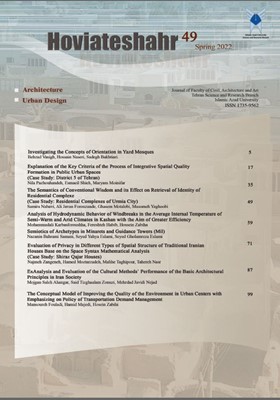Semiotics of Archetypes in Minarets and Guidance towers (Mil)
Subject Areas : architectureNazanin Bahrami Samani 1 , Seyed Yahya Eslami 2 , Seyed Gholamreza Eslami 3
1 - Ph.D. Candidate, Karaj, Islamic Azad University, Karaj, Iran.
2 - Assistant Professor, Department of Fine Art, Tehran University, Tehran, Iran.
3 - Professor, Department of Fine Art,, Tehran University, Tehran, Iran
Keywords: profile, minaret, icon, archetype, Symbol,
Abstract :
Signs, in ancient Iranian architecture, are of the key elements of structures and traces of them can be found all over the history of Iranian architecture. Most of worship places are featured with minaret and dome, so that variations of these elements can be found in holy places of all divine religions. Unfortunately, today we witness that these elements are neglected or even removed from architecture of holy places and mosques in particular. Although, innovation is an essential part of architecture, the historical identity of a culture needs to be respected, if we want to achieve a stable form in architecture. Minarets in Iranian architecture represent specific signs and symbols that have formed and matured intentionally over the years so that they are considered as an archetype. These elements take the observers’ imagination to the old ages and to find out human’s ancient mental connection. Todays, traces of different fields of science are evident in architecture. One of these is semiotics, which is the science of perceiving phenomena in the world. The present study focuses on semiotics of archetypes as the constant patters that are rooted in collective experience of man. Studying architectural specification of archetypes and how their concepts are used in Iranian minarets architecture is another objective of the study. In our approach to semiotics of archetypes in architectural structures, we need to know some basic definitions in semiotics. To this end, concepts like signs, semiology, architecture, minaret, and their multi-aspect and close relationship are discussed thoroughly. The study is aimed at examining how the archetypal signs are represented in old minaret architecture in Iran and the way of using them in contemporary architecture in Iran in compliance with Iranian culture and history. To do this, using analytical and interpretive method, the bidirectional relationship was examined through quantitative study (from theory to instance) and qualitative study (from instance to theory).The study was carried out as analytical library work based on the available references. After literature review and representing viewpoints of the pioneers of semiology about signs and comparing their theories, a comprehensive definition of archetypes was proposed. Then, the semiotic systems in architecture of minaret, based on the proposed definition, were examined through semantic approach. Finally, a method to recreate the signs in the structures was brought in. Thus, the study begins with surveying the concept of semiotics and archetypes followed by some examples of minarets that try to regenerate architectural signs and convey an indigenous sense, which were examined through semiotics viewpoint. Finally a theory about archetype semiotics of minaret and guidance tower of Iran was proposed. Surveys of archetypes semiotics indicated that minaret is one of the main archetypes that represents variety of mythical concepts and meanings. Thus, it is not reasonable to eliminate such a valuable element regardless of its archetype aspects and even without an acceptable replacement. It is not hard to understand that the developers of minarets have tried to convey a message to the future generationsKeywords: archetype, minaret, semiotics, symbol, icon
_||_


